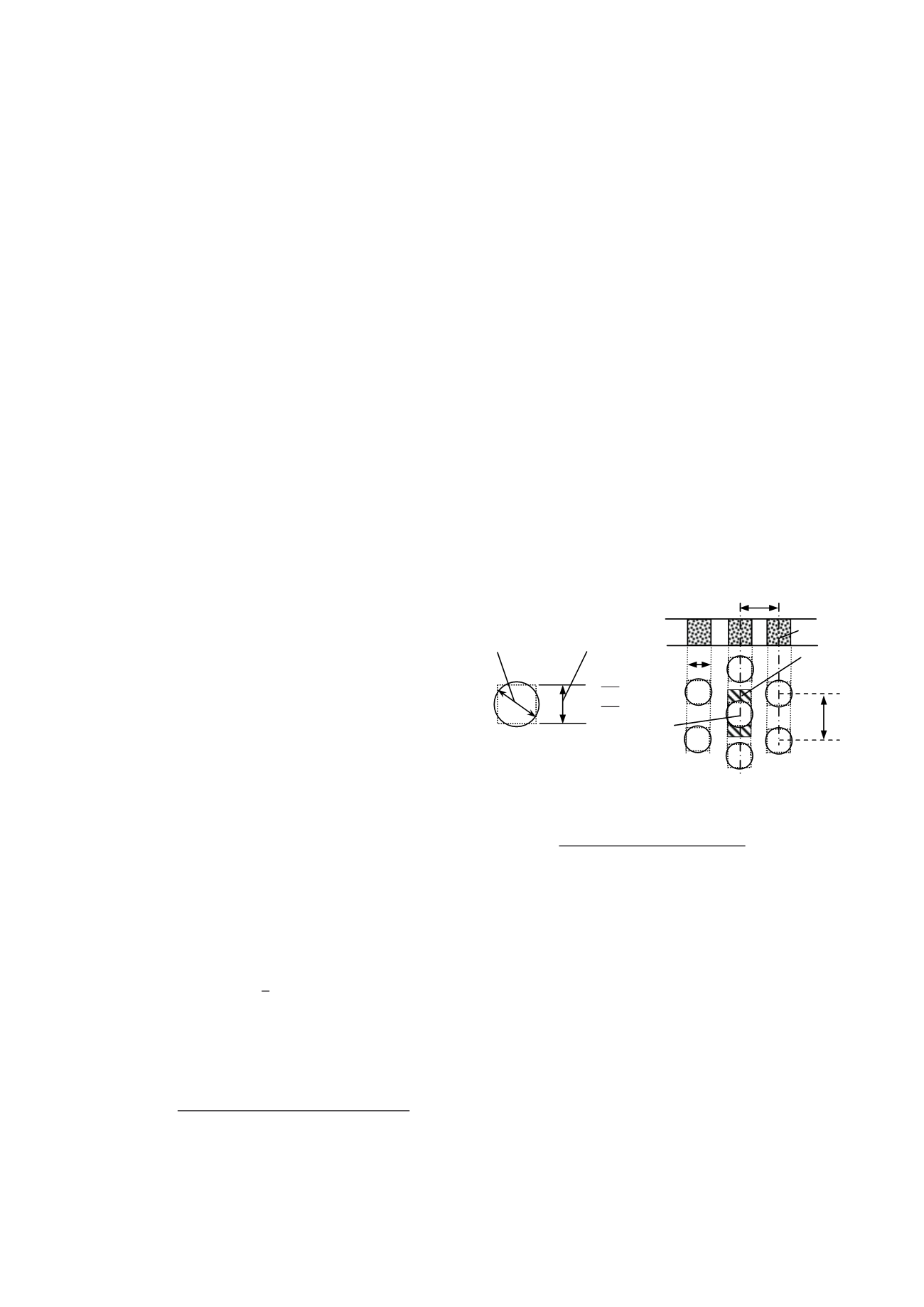
2585
Stress Concentration Ratio and Design Method for Stone Columns using 2D FEA with
Equivalent Strips
Ratio de concentration de contraintes et méthode de conception pour les colonnes ballastées en
utilisant une analyse aux éléments finis 2D avec des bandes équivalentes
Poon B., Chan K.
GHD Geotechnics, 57-63, Herbert Street, Artarmon, NSW, Australia
ABSTRACT: This paper presents an approach for the prediction of vertical and horizontal displacements of soft ground treated with
stone columns in a 2D finite element analysis (FEA). This involved modeling the columns as strips with appropriate strip width,
spacing and smeared properties based on stress concentration ratio. Charts to assess the equivalent 2D column stress concentration
ratio are provided for the design of full depth and floating columns under the influences of various key parameters. The accuracy of
the proposed 2D strip model is investigated by comparing the results with a baseline 3D and axi-symmetric FEA. It is found that the
proposed strip model is preferable over the conventional approach using composite block properties to represent the improved soil.
RÉSUMÉ : Cet article représente une approche pour la prédiction des déplacements verticaux et horizontaux de sols mous traités avec
des colonnes ballastées par une analyse aux éléments finis (FEA) en 2D. Cela implique la modélisation des colonnes en tant que
bandes avec une largeur de bande appropriée ainsi que l’espacement et les propriétés des zones d’influence basées sur le ratio de
concentration de contrainte. Les graphiques pour évaluer le ratio 2D équivalent de concentration de contraintes sont donnés pour la
conception des colonnes profondes et flottantes sous l'influence de divers paramètres. La précision du modèle de bande 2D proposé
est étudiée en comparant les résultats avec une base en 3D et d’une analyse aux éléments finis axisymétrique. Il se trouve que le
modèle de bande proposé est préférable à l'approche conventionnelle qui utilise les propriétés d’un bloc composite pour représenter le
sol amélioré.
ORDS: Stone column, stress concentration, ground improvement, numerical analysis.
1 INTRODUCTION
Conventionally, the design of stone columns involves the
prediction of settlements using a composite material approach in
which equivalent strength and deformation parameters are
derived using semi-empirical correlation to represent the entire
improved soil. While these approaches have been accepted as
reasonable methods for settlement prediction, they are less
certain for the prediction of horizontal displacement. This paper
presents a design approach where stone columns are idealised as
equivalent strips in 2D finite element analysis (FEA). The stress
distribution between the stone column and surrounding soil is
essential for determining the strength parameter of the
equivalent strips. A series of design curves for the stress
concentration are presented to facilitate parameter derivation in
practice. The accuracy of the 2D strip model is investigated by
comparing the results with the 3D and axi-symmetric FEA.
2 IDEALISED 2D MODELLING APPROACH
For the modeling of stone columns in 2D FEA, the width of the
stone column strips can be made to be equal to the width of an
equivalent square for the cross-sectional area (Figure 1). The
spacing of the strips is equal to the actual spacing,
b
, for square
column arrangement and
√3/2
for equilateral triangular
arrangement. Mohr-Coulomb model is used for the stone
columns with Poisson’s ratio of 0.3, which is taken to be the
same as the soil itself. The equivalent Young’s modulus
E
eq
and
the cohesion
c
eq
of the strips can be calculated based on
weighted average approach as given by Eq 1.
=
∙
∙
where
A
soil
and
A
column
are the areas of the soil and column
inside a unit cell within the 2D strip as shown in Figure 1.
Figure 1. 2D stone column strips
The equivalent friction angle
φ
eq
of the strips can be derived
based on force equilibrium approach as given by
=
∙
∙
The determination of
φ
eq
requires a presumption of stress
concentration,
n
, which is defined as the ratio of the average
applied vertical stress within stone column to the average
applied vertical stress of the surrounding soil at the same level.
Section 3 presents an appraisal for this parameter. Note that the
present 2D FEA is an elasto-plastic analysis in which the decay
of excess pore pressure with time was not taken into account.
3 STRESS CONCENTRATION OF STONE COLUMN
This section presents a series of elasto-plastic solutions in charts
for the stress concentration (
n
) of stone columns founded on (i)
rigid boundary and (ii) infinite compressible soil materials. The
solutions were obtained based on axisymmetric FEA using
PLAXIS software programme for a “unit cell” consisting of a
stone column and the surrounding soil within a column’s zone
of influence. Interface elements were introduced at the soil-
column contact to allow for slippage. The interface strength was
assumed to be 70% of the original soil strength (R
int
= 0.7 in
PLAXIS). Note that the interface properties have minimal effect
on the results as the stone column is in triaxial state.
A
column
A
soil
b
2D strip
b cos30º
a
(
1
)
d
=
4
d
= diameter of
stone column
a
= width of equivalent
strip in 2D FEA
(
2
)


